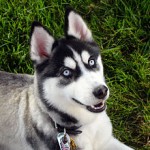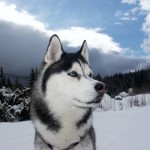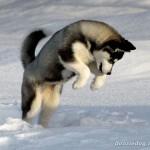Siberian Huskies are strong, compact, working sled dogs. The medium sized head is in proportion to the body, with a muzzle that is equal in length to the skull, with a well defined stop. The color of the nose depends upon the color of the dog’s coat. It is black in gray, tan or black dogs, liver in copper dogs and flesh-colored in pure white dogs. The medium sized, oval shaped eyes are moderately spaced and come in blue, brown, amber, or any combination thereof. Eyes can be half blue and half brown, (parti-eyed) or can have one blue eye and one brown eye. The erect ears are triangular in shape, set high up on the head. The teeth meet in a scissors bite. The tail is carried over the back in a sickle curve, not curved to either side when the dog is excited. The large “snow shoe” feet have hair between the toes to help keep them warm and for gripping on ice. Dewclaws are sometimes removed. The medium length, double coat is thick and can withstand temperatures as low as -58 degrees to -76 degrees F ( -50 degrees to -60 degrees C). Coat colors include all from black to pure white, with or without markings on the head. The face mask and underbody are usually white, and the remaining coat any color. Examples of common colors are black and white, red and white, brown, gray and white, silver, wolf -gray, sable and white, red-orange with black tips, dark gray and white. Pie-bald is a very common coat pattern.
———————————————————————————————————————-
Siberian Huskies son fuertes, compactos, trabajan perros de trineo. La cabeza es de tamaño mediano en proporción al cuerpo, con un hocico que es de igual longitud que el cráneo, con un stop bien definido. El color de la nariz depende del color del pelo del perro. Es de color negro en perros grises, marrón o negro, el hígado en los perros de cobre y de color carne en perros totalmente blancos. El medio de los ojos de tamaño, forma ovalada están moderadamente separados y vienen en azul, marrón, amarillo, o cualquier combinación de éstos. Los ojos pueden ser la mitad azul y mitad marrón, o puede tener un ojo azul y un ojo marrón. La orejas erectas son de forma triangular, establece en lo alto de la cabeza. Los dientes se unen en una mordida de tijera. La cola es llevada sobre la espalda en una curva de hoz, no se curva hacia los lados cuando el perro está excitado. Los grandes “con raquetas de nieve” los pies tienen pelo entre los dedos de los pies para ayudar a mantener el calor y para el agarre en hielo. Los espolones son a veces eliminados. La longitud media, doble capa es gruesa y puede soportar temperaturas tan bajas como -58 grados a -76 grados F (-50 º a -60 º C). Los colores del pelaje son todos de negro a blanco puro, con o sin marcas en la cabeza. La máscara de la cara y debajo de la carrocería son generalmente de color blanco, y la capa restante de cualquier color. Algunos ejemplos de los colores más comunes son de color negro y rojo, blanco y negro, marrón, gris y blanco, la plata, el lobo gris, sable y blanco, rojo-anaranjado con las puntas negro, gris oscuro y negro. Pie-calvo es un patrón de pelaje muy común.



